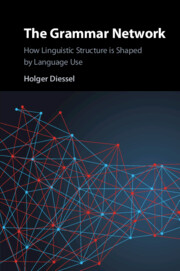Book contents
- The Grammar Network
- The Grammar Network
- Copyright page
- Contents
- Figures
- Tables
- Preface
- Abbreviations
- 1 Introduction
- Part I Foundations
- Part II Signs as Networks
- 4 The Taxonomic Network
- 5 Sequential Relations
- 6 Symbolic Relations
- Part III Filler–Slot Relations
- Part IV Constructional Relations
- References
- Author Index
- Subject Index
5 - Sequential Relations
from Part II - Signs as Networks
Published online by Cambridge University Press: 12 August 2019
- The Grammar Network
- The Grammar Network
- Copyright page
- Contents
- Figures
- Tables
- Preface
- Abbreviations
- 1 Introduction
- Part I Foundations
- Part II Signs as Networks
- 4 The Taxonomic Network
- 5 Sequential Relations
- 6 Symbolic Relations
- Part III Filler–Slot Relations
- Part IV Constructional Relations
- References
- Author Index
- Subject Index
Summary
All linguistic elements, e.g., words, phrases and clauses, occur in sequential order. The sequential arrangement of linguistic elements is motivated by conceptual and pragmatic factors, but the strength of sequential relations is primarily determined by automatization or chunking. Since automatization is a gradual process driven by frequency of occurrence, sequential relations vary on a continuum. Moreover, since language unfolds in time, sequential relations have an inherent forward orientation, which is reflected in the fact that listeners are able to “predict” upcoming elements in the unfolding speech stream. Chapter 5 considers the effect of automatization and chunking on the development of linguistic structure and the cognitive organization of grammar. The chapter is divided into two parts. The first part is concerned with research on lexical prefabs and the organization of morphological network models, and the second part considers sequential aspects of constructional schemas and the gradience of constituency.
Keywords
- Type
- Chapter
- Information
- The Grammar NetworkHow Linguistic Structure Is Shaped by Language Use, pp. 63 - 89Publisher: Cambridge University PressPrint publication year: 2019

